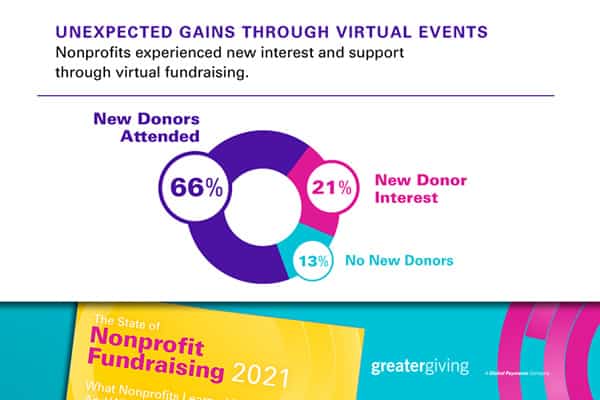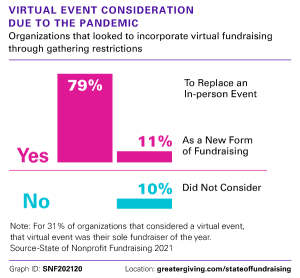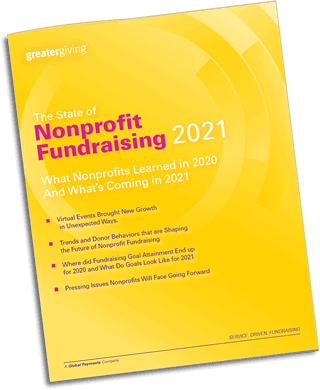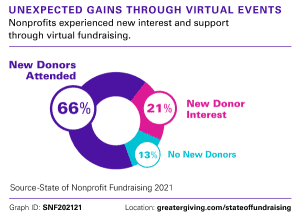
The world of nonprofit fundraising changed dramatically in the last eighteen months.
We’ve detailed many of these shifts, and the lessons learned from them, in the recently-published The State of Nonprofit Fundraising report.
As nonprofits were forced to postpone, and often cancel, their large, in-person fundraising galas, something else took its place: the virtual event. But it was not a one-to-one conversion. Nonprofits held many virtual events throughout the year—potentially kicking off an industry-wide trend that would change how we view event-based fundraising.
Despite a Pandemic, Nonprofits Held a Lot of Events Last Year
 Virtual events dominated the space formerly occupied by staple annual fundraising galas. 90% of nonprofits reported that they had considered holding a virtual event last year. Despite restrictions on large gatherings, an overwhelming majority still held a fundraising event of some kind. More than half of nonprofits surveyed for The State of Nonprofit Fundraising reported holding two to five events in 2020, while 7% said they held six or more. Aggregated, nonprofits held an average of 3.94 events—a surprising amount of activity during a pandemic.
Virtual events dominated the space formerly occupied by staple annual fundraising galas. 90% of nonprofits reported that they had considered holding a virtual event last year. Despite restrictions on large gatherings, an overwhelming majority still held a fundraising event of some kind. More than half of nonprofits surveyed for The State of Nonprofit Fundraising reported holding two to five events in 2020, while 7% said they held six or more. Aggregated, nonprofits held an average of 3.94 events—a surprising amount of activity during a pandemic.This tells us that without the typical annual, in-person fundraising event to supplement budgets, nonprofits filled the gap with many smaller, virtual events spread out across the year. What drove this new practice, and will it continue beyond the pandemic?
Virtual Events Cost Less
Putting on a beautiful signature gala is usually an expensive endeavor, requiring a venue, catering, stage and sound management, decoration, and more. While some costs can be covered by sponsorships, a significant portion of a live event’s overall revenue still goes toward related expenses.
Virtual events presented an interesting new direction for nonprofits: what if your cost was significantly lower? Event costs didn’t completely vanish—virtual events still require legwork, preparation, and some vendor services. Running a livestream is an investment of time and often money, and many nonprofits hired production and audio-video vendors to create high quality, immersive programs for virtual guests. And an online auction relies on some form of event management software just like an in-person auction would, as do any ticket sales.
To test the hypothesis that virtual events produced a better cost-to-revenue ratio, we asked fundraisers in the State of Nonprofit Fundraising report how their event costs changed between their live events and virtual events, in relationship to their fundraising goals. (Many nonprofits set their goals significantly lower for virtual events, knowing it was new territory, and some organizational costs included service deposits paid for canceled events.)
31% of respondents said their costs did not change, while 41% reported a decrease in costs over previous live events. (Last year, 37% of nonprofits said they saw sponsorship losses, which could have led to organizations having to cover more event costs themselves.)
For most nonprofits, this was their first time holding a purely virtual event. We were impressed! 23% of nonprofits reported exceeding their fundraising goals, 15% met their goals, and 62% came in under. This wasn’t surprising, given the rapid rate at which nonprofit organizations were forced to learn brand new technology. Overall, they rated their virtual event success as 6 out of a possible 10, showing this new approach succeeded as a quick stop-gap in a time of crisis.
Many Smaller Events = Bigger Reach, Stable Revenue
Nonprofit organizations most definitely see virtual events as a staple in the years ahead, even as the possibility of holding small, in-person gatherings appears on the horizon. We asked nonprofits about their plans in the coming year, and 84% answered that they were likely to hold virtual events in the future.
 That’s not surprising, given virtual events are capable of reaching broader audiences than ever before. 66% of nonprofit organizations who held a virtual event said they had brand new donors attend, and 21% reported new interest in their cause, demonstrating that virtual events allowed nonprofits to find new supporters in their communities and around the world.
That’s not surprising, given virtual events are capable of reaching broader audiences than ever before. 66% of nonprofit organizations who held a virtual event said they had brand new donors attend, and 21% reported new interest in their cause, demonstrating that virtual events allowed nonprofits to find new supporters in their communities and around the world.
While we don’t foresee virtual events completely taking the place of the annual signature gala in the long term, nonprofits have seen the revenue potential in allowing guests to participate remotely. Virtual events will, most likely, assume their own separate position in yearly fundraising activities as a part of a more diversified event strategy. Not only because they can court supporters outside their usual reach, but also because a wider variety of events allows nonprofits to engage the same donors multiple times, in multiple ways—think golf tournaments, peer-to-peer fundraising competitions, online raffles, games, and more. And virtual events offer a good bang for your buck! Costs will likely decrease as they become more familiar and mainstream, and revenue will increase as organizations widen their supporter base from event to event.
If nonprofits give their passionate donors more opportunities to get involved, they will rise to the task. And putting more eggs in more baskets decreases risk, and creates a more reliable, spread out revenue stream.
In an uncertain future, more possibilities mean more versatility, and the ability to take on new challenges as they come—an essential skill as the public health, and the world around us, continue to shift in 2021 and beyond.

One Response to “Will Nonprofits Move Away from One Big Gala Every Year?”